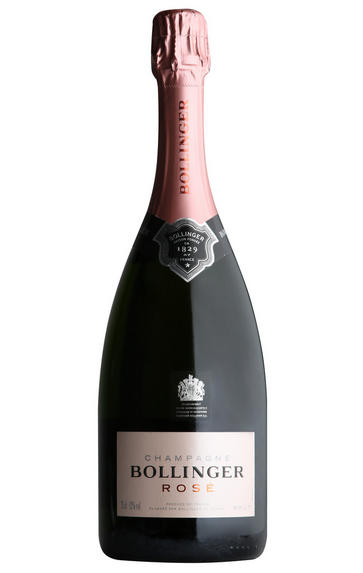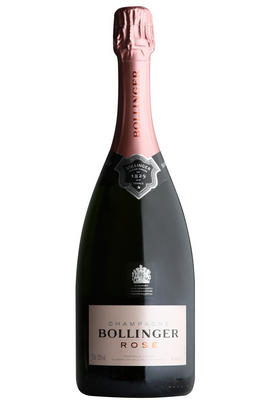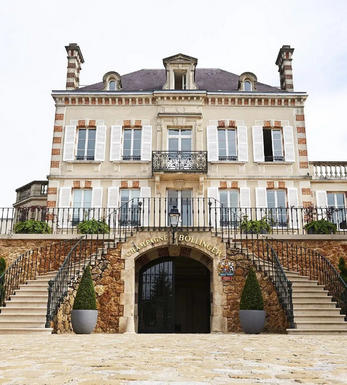
Champagne Bollinger, Rosé, Brut

Critics reviews
Pretty notes of strawberry and cherry are trimmed in yeast, quinine and citrusy nuances, where the latter is picked up by the delicious and vibrant middle-weight flavours where the supporting mousse is dense and moderately fine while the finish is clean, dry and complex. For my taste, this is drinking perfectly now though it could easily be held if desired.
Drink now
Allen Meadows, Burghound.com (January 2022)
The latest release of Bollinger's NV Brut Rosé shows exceptionally well, offering complex aromas of sweet stone fruit, honeycomb, freshly baked bread and orange oil, followed by a medium to full-bodied, pillowy and vinous palate. Layered and concentrated, with a pretty pinpoint mousse and ripe but racy acids, it concludes with a long, expansive finish.
Drink 2021 - 2035
William Kelley, Wine Advocate (August 2022)
62% Pinot Noir, 24% Chardonnay, 14% Pinot Meunier. Winemaker: Gilles Descôtes. RS 7–8 g/l.
Pale to mid salmon. Light Pinot perfume. Well-managed mousse is just the right side of not-too-aggressive. Good balance of fruit and a dry finish. Serious rosé champagne, but definitely not hard work to drink now.
Drink 2022 - 2025
Jancis Robinson MW, JancisRobinson.com (May 2022)
Deep red-berry nose, plus some nectarine, spice and candied-orange notes. Powerful and fresh, the creaminess neatly balances the hint of tannin from the red-wine component of the blend—excellent textural complexity, then a long, delicately spicy and mineral finish.
Disgorged in June 2021
Drink now
James Suckling, JamesSuckling.com (July 2022)
The NV Champagne Brut Rosé has a pale pink hue and lifts with a soft bouquet of red raspberry, apricot, bread dough, blood orange, and delicate smoke. The palate is approachable, with a well-tailored structure, pleasant bitter citrus notes of orange and grapefruit, and a floral element through the finish. It is well-balanced and versatile for pairing at the table.
Drink 2022 - 2037
Jeb Dunnuck, JebDunnuck.com (July 2022)
About this WINE

Bollinger
The Champagne House of Bollinger was established in 1829 by Jacques Bollinger and Paul Renaudin. Over the years the vineyard holdings have been steadily increased with the largest expansion taking place under the stewardship of the legendary Mme Lily Bollinger. She ran the company between 1941 and 1977 and today it is managed by her great-nephew, Ghislain de Montgolfier.
Bollinger has a reputation for producing muscular champagnes with body, depth and power, and is today considered one of the "Great" Champagne houses.
70% of the grapes come from the firm's own vineyards. 80% of the harvest is barrel-fermented with the wines being kept on their yeast lees for an extended period of time (in the case of the RD, around 10 years).
Bollinger produces classic, complex, Pinot-Noir dominated champagnes with the ability to age gracefully for many years.

Rosé Champagne
Rosé wines are produced by leaving the juice of red grapes to macerate on their skins for a brief time to extract pigments (natural colourings). However, Rosé Champagne is notable in that it is produced by the addition of a small percentage of red wine – usually Pinot Noir from the village of Bouzy – during blending.
Recommended Producers : Billecart Salmon (Elizabeth Salmon Rose), Ruinart

Champagne blend
Which grapes are included in the blend, and their proportion, is one of the key factors determining the style of most Champagnes. Three grapes are used - Pinot Noir, Chardonnay and Pinot Meunier.
26% of vineyards in Champagne are planted with Chardonnay and it performs best on the Côtes des Blancs and on the chalk slopes south of Epernay. It is relatively simple to grow, although it buds early and thus is susceptible to spring frosts. It produces lighter, fresher wines than those from Burgundy and gives finesse, fruit and elegance to the final blend. It is the sole grape in Blancs de Blancs, which are some of the richest long-lived Champagnes produced.
Pinot Noir accounts for nearly 40% of the plantings in Champagne and lies at the heart of most blends - it gives Champagne its body, structure, strength and grip. It is planted across Champagne and particularly so in the southern Aube district.
The final component is Pinot Meunier and this constitutes nearly 35% of the plantings. Its durability and resistance to spring frosts make the Marne Valley, a notorious frost pocket, its natural home. It ripens well in poor years and produces a soft, fruity style of wine that is ideal for blending with the more assertive flavours of Pinot Noir. Producers allege that Pinot Meunier lacks ageing potential, but this does not deter Krug from including around 15% of it in their final blends.


Buying options
Add to wishlist
Description
Champagne Bollinger is famed for its rich house style. This is partly because 80% of each Bollinger harvest is matured in oak barrels adding depth, complexity and texture. The nose tantalises with aromas of strawberry, orange blossom and warm cherry.
The palate is wonderfully rounded, adding some cream to those strawberry flavours and a hint of rose petal. Enjoy this fresh and lively Champagne with grilled prawns or strawberries and cream.
Drink now
Alexandra Gray de Walden DipWSET, Berry Bros. & Rudd (June 2023)
wine at a glance
Delivery and quality guarantee